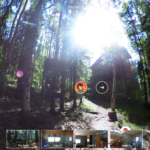Instructor Presence
Engage students and share your expertise by being present in your course.
What is instructor presence?
Your presence is a key factor in building student engagement in your course. This means a physical or visual presence — your picture, videos of you talking to / instructing students — as well as your unique angle on course materials and how you deliver them. When you put you into your course, students are more likely to reciprocate and dedicate effort to the course as well.
How Can I Use Instructor Presence in My Course?
Instructor’s presence includes things like:
- a personal introduction at the beginning of the course that includes photos or video
- your perspective on each topic
- your relevant stories in your lecture materials
- providing links to current information in lecture materials and notes
- the value-added experience/expertise/reflection that you give to the course content
- important elements of the topic that aren’t in the course textbook
- expert interviews/journal articles with an explanation of why they were chosen
- your feedback to student work, including written comments, video response, and/or occasional one-to-one conferences
- your availability for one-to-one communication with students — via email, chat, office hours (face-to-face or virtual)
Cormier and Siemans (2010) have a handy taxonomy of the roles that instructor presence fills to create a rewarding online learning environment.
- Amplifying: Drawing attention to important ideas/concepts
- Curating: Arranging readings and resources to scaffold concepts
- Wayfinding: Assisting learners to rely on social sense-making through networks
- Aggregating: Displaying patterns in discussions and content
- Filtering: Assisting learners in thinking critically about information/conversations available in networks
- Modeling: Displaying successful information and interaction patterns
- Staying Present: Maintaining continual instructor presence during the course, particularly during natural activity lulls
How-To Instructions and DIY
Here is a list of Links to “How To” Instructions:
- CTL page on creating video
- Webinar: Ways to communicate with students in Canvas
- Short videos explaining the basics of using Announcements and Discussions in Canvas
Considerations for Online Courses
If you’re teaching an online course, your presence is both harder to achieve and essential for helping students connect to their learning. Video is a straightforward way to get your presence into the course — try creating an intro video for the course and try introducing a few assignments with video. You can also give feedback to students using a simple webcam on your computer — this can be both quicker for you in your grading process, and can help students connect to what you’re saying.
To give your perspective on course materials be sure to write your own framing intro for each unit, and try using announcements to keep regular contact and give your ideas about what students will be encountering this week/module. When you come across an article or news story that’s relevant, share it with students in an announcement, discussion thread, synchronous session, or video lecture.
Instructor-created video is often emphasized in online course creation, but it’s good to remember that video is not the single best way to add instructor presence to your course. Many people find creating video of themselves to be an awkward and anxiety-ridden process. Lean on methods of communication that allow you to be comfortable and present your best instructor self — email and announcements, live chat, phone calls or web conferencing, memes, or audio recordings. If you are interested in experimenting with adding video to your course, start small and be creative. There are lots of tricks out there for getting more comfortable in front of the camera and it’s a skill that gets easier with practice.
In Practice

Research Writing
Research Writing course (ENGL-414) uses WordPress and an interactive, 360-degree space to deliver learning materials and assignments.
Watch a Sample Course Introduction
Research Foundations
Baker, C. (2010). The impact of instructor immediacy and presence for online student affective learning, cognition, and motivation. Journal of Educators Online, 7(1).
Ladyshewsky, R. K. (2013). Instructor presence in online courses and student satisfaction. International Journal for the Scholarship of Teaching and Learning, 7(1).
Richardson, J. C., Koehler, A. A., Besser, E. D., Caskurlu, S., Lim, J., & Mueller, C. M. (2015). Conceptualizing and investigating instructor presence in online learning environments. The International Review of Research in Open and Distributed Learning, 16(3).
Sheridan, K., & Kelly, M. A. (2010). The indicators of instructor presence that are important to students in online courses. Journal of Online Learning and Teaching, 6(4).
Cormier D. & Seimens G. (2010). Through the Open Door: Open Courses as Research, Learning, and Engagement. EDUCAUSE Review, 45(4).
